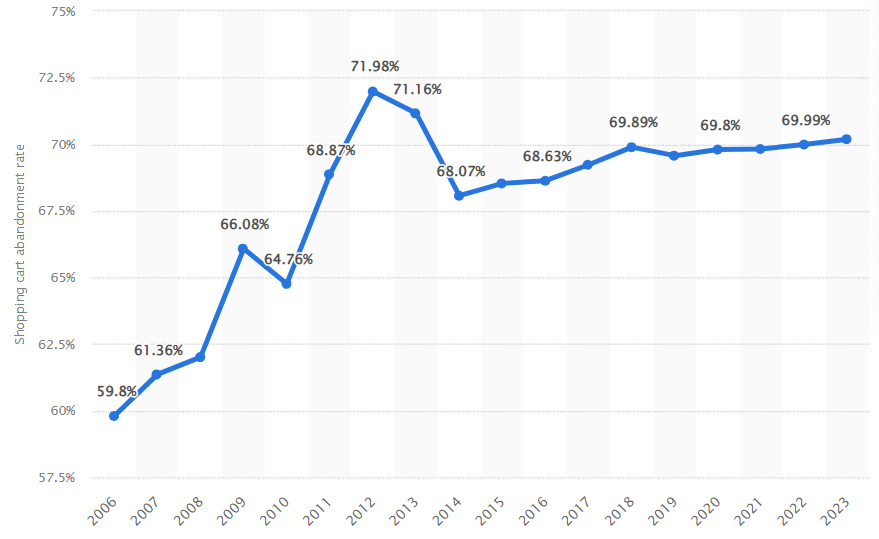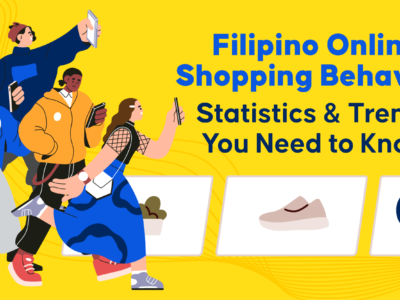Not so long ago, e-commerce was only a vision that business folks at Amazon and eBay tried to explore as they searched for a new way to sell things. It worked, making online shopping the next big thing after the World Wide Web.
Today, online selling has become the bare minimum for retailers. With digital consumers’ ever-evolving needs and expectations, you must keep your e-commerce strategies up to date or risk getting left behind. Here are the latest e-commerce statistics for businesses to give you an idea of what’s happening in the industry today.
E-commerce Statistics Every Retailer Should Know
Understanding the current e-commerce industry statistics can help you adjust your operations accordingly and stay ahead of your competitors.
1. 2025 could see e-commerce sales totaling $7.39 trillion (eMarketer)
Online shopping is growing steadily, opening up more business opportunities for entrepreneurs like yourself. If you want to explore a new business idea, incorporate e-commerce channels into your business plan. Not doing so may mean ignoring a large portion of your target market and failing to maximize your business’s growth.
2. Over 19% of worldwide retail sales in 2022 came from e-commerce transactions and could reach 25% by 2027 (Statista)
There’s a noticeable uptick in people shopping online as more tech-savvy generations come to age. Despite already being a formidable market, the latest e-commerce growth statistics reveal that the industry is still growing faster than any other channel, indicating high levels of sustainability in the long run.
3. 70% of online carts were abandoned in 2023—a new high since 2013 (Statista)

You can mine endless data about customer preferences and buyers’ journeys from cart abandonment rates. If you continue tracking them, you’ll know better how to improve the shopping experiences of people using your website and encourage them to complete their purchases.
4. 3% of e-commerce conversions occurred on desktops, laptops, and tablets in Q2 2022, while smartphones accounted for 2% (Adobe)
Measuring your conversion rates gives you an overview of your marketing strategy’s performance. You could perform a conversion rate optimization audit to evaluate the customer journey on your website and identify bottlenecks hindering conversions, before adjusting your tactics accordingly to drive positive results.
5. 2.65% of TikTok users directly interact with a brand’s marketing materials, significantly more than Instagram (0.70%) and Facebook (0.15%) (Socialinsider)

TikTok, with its focus on short and highly entertaining video content, has the highest engagement rate among its competitors. Still, other platforms could help you achieve various marketing goals, like building brand awareness and interest, targeting and engaging audiences, and promoting your products and services.
6. 71% of shoppers only buy from sites offering free returns (Rithum)
Aside from in-store returns, include free mail-in returns, scheduled pick-up services, or online exchanges. These tactics may be costly, but they can boost conversion rates, encourage repeat purchases, and improve brand perceptions.
7. In 2022, livestream e-commerce sales reached $17 billion, which may triple in 2026 (Statista)
The live commerce trend began in China during the height of the COVID-19 pandemic lockdowns, resulting in gross sales worth $486.5 billion in 2022. Most of the world followed suit because of its potential. Today, livestream e-commerce enables companies worldwide to deliver better experiences and achieve greater customer engagement, creating a new billion-dollar marketing strategy.
8. $20.4 trillion was the value of the global B2B e-commerce market in 2022—over five times that of the B2C market (Statista)
When people think about e-commerce, they often imagine consumer retail, like eBay and Amazon. It might lead some B2B businesses to believe it’s not the right channel for their customers. Don’t make the same mistake because the proof is clearly in the pudding with big-name B2B brands like Alibaba prospering today.
9. There were $2.2 trillion worth of mobile commerce transactions in 2023, making up 60% of e-commerce sales worldwide (Statista)

Recent mobile commerce statistics show smartphone users shop straight from their mobile devices. As you invest in either a mobile site or mobile app, cover all the bases to provide a mobile-friendly buying experience to customers. The trick is to make browsing, ordering, and checkout processes as simple, intuitive, and convenient as possible.
10. In 2024, the global conversational commerce market is expected to reach $7.61 billion. It could reach $34.41 million by 2034 at a 16.3% CAGR (Future Market Insights)
Don’t miss out on implementing conversational commerce, an emerging strategy allowing customers to go through the buyer’s journey from messaging apps. Maximize these platforms to help in critical aspects of your business, including automating your customer service, personalizing your marketing, and even driving sales. It’s an excellent way for e-commerce brands of all shapes and sizes to scale sustainably.
11. Between 2019 and 2023, the number of e-commerce sites worldwide grew from 9.2 million to 26.5 million (Markin Blog)

The e-commerce landscape has become more competitive in recent years. As such, you must maximize innovative strategies to stay ahead of your competitors. Consider implementing technical SEO for better visibility, improving customer services and experiences, or adapting personalized marketing strategies to make your e-commerce site stand out.
12. 28% of millennials admit that their primary reason for using social media is to find products to buy (GWI)
As more members of the younger demographic of online shoppers enter the workforce, it’s imperative to take advantage of the social media platforms they use. For instance, most Gen Zs and millennials use social networking sites like Facebook, Instagram, and TikTok, and a sizeable portion of them use these channels to make new purchases. These figures emphasize social media marketing as an effective way to boost your visibility among young buyers.
13. By 2030, the sustainable e-commerce market may surpass $40.75 billion at a CAGR of 15.38% (Global News Wire)
Shoppers are becoming more aware of the sustainability of their purchases. In fact, 73% of consumers would change their consumption habits to reduce their environmental impact. This shift in buyer behavior means you may have to implement more sustainable business practices and showcase these changes on your marketing materials to appeal to a more eco-conscious customer base.
14. 45% of millennials and Gen Zs want personalized product recommendations when shopping online (Statista)
Tailoring shopping experiences to each customer’s preferences could improve their satisfaction with your brand and, ultimately, drive more conversions. Aside from product recommendations, you may also implement highly targeted promotions or establish communication channels that use customer data to personalize interactions.
15. A 25% improvement in customer satisfaction, revenue, or cost reduction awaits organizations that used AI for e-commerce in 2024 (Gartner)
Artificial intelligence has become a valuable tool among e-commerce businesses for simplifying internal operations and making customer interactions more efficient. For example, marketers have begun using AI-powered chatbots to provide round-the-clock customer service. Some also use it to power big data gathering and analytics, making these tedious tasks more manageable.
*Bonus e-commerce trends and statistics (courtesy of Jobs in Marketing)

Other E-Commerce Stats
Need more insights on e-commerce trends? Leverage these additional online commerce statistics to inform your decision-making and give your business an edge.
- 66% of consumers reveal that customer reviews often influence their shopping journey, while 62% say the same for star ratings (Trustpilot)
- 55% of Gen X shoppers want e-commerce sites to implement frictionless payment methods (Statista)
- 41% of millennials and Gen Zs make impulse purchases every two to three weeks—and at 48%, this figure is higher among daily TikTok users (GWI)
- People who recently bought online are 1.4x as likely to buy from the same seller again, 2x as likely to buy from an unfamiliar brand, and 2x as likely to buy recommended product or service bundles (Accenture)
- 81% of buyers worry about how companies use their data, and 72% are more likely to support brands they can trust with it (HubSpot)
- 69% of shoppers admit that marketing videos should be more authentic and relatable than polished with high-quality video and audio (HubSpot)
- Over 9 out of 10 North American businesses are expanding their e-commerce operations to social media. Meanwhile, 73% have already successfully sold via these platforms (Statista)
- 41% of consumers have discovered a product on social media between June and August 2023 (HubSpot)
- 78% of retail site traffic occurred on smartphones, generating two-thirds of e-commerce orders in Q4 2024 (Statista)
- In 2023, the conversion rate of online shoppers worldwide was below 2%. Beauty and skincare products incurred the highest conversion rates (Statista)
- 57% of online shoppers have bought goods and services from abroad (PayPal)
- 46% of consumers are more likely to support brands offering new digital experiences (PayPal)
- 57% of buyers spend more on items they can enjoy with family and friends (PayPal)
- 47% of shoppers abandon their carts due to high shipping costs, taxes, and other fees, according to new shopping cart abandonment stats. Moreover, 25% do so to avoid creating another account, while 24% do so due to slow delivery times (Baymard Institute)
- 12 to 14 elements on checkout forms are the ideal amount for maximum user-friendliness, but the average checkout flow in practice contains roughly 23 elements (Baymard Institute)
What’s Next for E-commerce?
It used to be baffling how buying and paying for things online worked, but over time, the system has grown in ways no one could have imagined back when it all started. As online shopping becomes more and more mainstream, it’s important to always keep an eye out as to where e-commerce is headed next.
Being successful in online retail can be difficult for brands with limited marketing knowledge and resources, but you can always call on the e-commerce experts at Spiralytics. Our marketing team can help you conquer the e-commerce landscape and keep your business attuned to the times!







